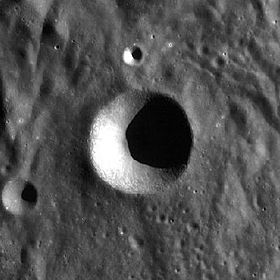Heyrovsky crater ( lat. Heyrovsky ) is a small impact crater in the southern part of the Cordillera Mountains on the far side of the Moon . The name was given in honor of the Czech chemist Jaroslav Heyrovsky (1890-1967) and approved by the International Astronomical Union in 1985.
| Heyrovsky | |
|---|---|
| lat Heyrovsky | |
 Snapshot of the Lunar Reconnaissance Orbiter probe. | |
| Specifications | |
| Diameter | 16.7 km |
| Deepest | 2600 m |
| Title | |
| Eponym | Jaroslav Heyrovsky (1890-1967) - Czech chemist, winner of the Nobel Prize in Chemistry (1959). |
| Location | |
| Heavenly body | Moon |
Content
Crater Description
The nearest neighbors of the Heyrovsky crater are the Focas crater in the north; Drude crater in the east-northeast; Graff crater in the east-southeast and Rydberg crater in the south. In the north of the crater are the mountains of the Hands and, further to the north, the East Sea [2] . The selenographic coordinates of the center of the crater are , diameter 16.7 km [3] , depth 2600 m [4] .
The Heyrovsky crater has a circular cup shape with a small flat bottom area. The shaft is clearly delineated, the inner slope is smooth, with a high albedo . The height of the shaft above the surrounding terrain reaches 600 m [4] . According to morphological features, the crater belongs to the BIO type (by the name of a typical representative of this class - the Bio crater).
Before obtaining its own name in 1985, the crater had the designation Drude S (in the designation system of the so-called satellite craters located in the vicinity of the crater, which has its own name).
Satellite craters
None.
See also
- List of craters on the moon
- Moon crater
- Morphological catalog of craters of the moon
- Planetary Nomenclature
- Selenography
- Mineralogy of the Moon
- Geology of the Moon
- Late heavy bombardment
Notes
- ↑ Map of the far side of the moon.
- ↑ Crater Heyrovsky on the map LAC-123
- ↑ Directory of the International Astronomical Union
- ↑ 1 2 Lunar Impact Crater Database . Losiak A., Kohout T., O'Sulllivan K., Thaisen K., Weider S. (Lunar and Planetary Institute, Lunar Exploration Intern Program, 2009); updated by Öhman T. in 2011. Archived page .
